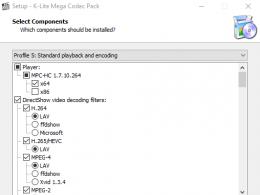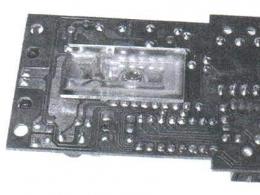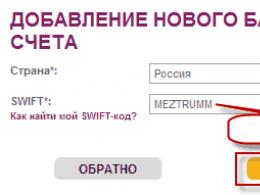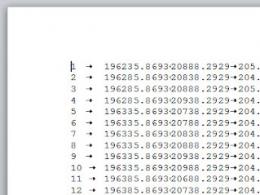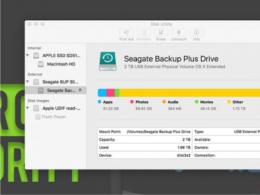How to reinstall windows 8 on an asus laptop. Reinstalling Windows without a disk or flash drive
How to reinstall Windows 8 on a laptop. Hello admin, my problem is the following. I bought a laptop with installed Windows 8 for one language (Windows 8 Single Language), which I successfully demolished and installed Windows 7. I used your article for instructions. Now I’ve changed my mind and want to install Windows 8 again, but I don’t want to install the exact version that was preinstalled on the Windows 8 Single Language laptop. I have a licensed disc in a box of Windows 8 Professional 64-bit Rus (OEM) with a key, I bought it in a store, that is, everything is as it should be. But, when I try to install this Windows version 8 Professional 64-bit Rus (OEM) the message “The entered product key does not match any of the Windows images” appears on the laptop.
The second option for reinstalling Windows 8 on a laptop
We will install a different edition of Windows 8 on our laptop, namely, we will use the existing one Windows disk 8 Professional 64-bit Rus (OEM).
Why, when installing a different edition of Windows 8 on a laptop, does the error “The entered product key does not match any of the Windows images” appear? ? Because information about the manufacturer's installed Windows laptop 8 Single Language and its key are stored in the UEFI BIOS.
But all professionals know that there is such a file (EI.cfg) and a product identifier file (PID.txt) - this additional files configurations that can be used during the Windows installation process to specify the product key and edition of Windows!
Attention friends! In simple words, program Windows installer 8, during installation, first of all refers to the EI.cfg configuration file (it indicates the edition of Windows 8 being installed) and the PID.txt file (it indicates the key of Windows 8 being installed). If these files are not present, Windows 8 reads information about the system version and its key in the UEFI BIOS of your laptop, and this key is from the Windows 8 Single Language installed by the manufacturer (for one language), and this is where the error comes out. So, friends, we will independently create these two files (EI.cfg) and product identifier (PID.txt) and indicate in them information about the Windows 8 Professional 64-bit Rus (OEM) we are installing, then we will place them in the sources folder Windows distribution 8, that's all.
How to do it?
1) For example, I have a licensed disk with Windows 8 Professional 64-bit Rus (OEM) or its image in ISO format. So the easiest way for me is to create a bootable USB flash drive for Windows 8.
- Attention! If you reinstall Windows 8 with UEFI BIOS enabled, it means bootable Windows flash drive 8 should be UEFI, how to create it and how to configure the UEFI BIOS itself to reinstall Windows 8, read in our article. this method involves the creation bootable flash drive by using command line . Know that using such a flash drive you can reinstall Windows 8 on a laptop with simple BIOS. So, we have created a flash drive, now we create two system installation configuration files (EI.cfg) and (PID.txt) and add them to the “sources” folder of the Windows 8 distribution.
- Note: Windows 8, 8.1 can also be installed using a simple ISO image, but then you need to add the above-mentioned files (EI.cfg) and (PID.txt) to it; sometimes it will even be enough to add just one pid.txt file to the sources folder with Windows key. You can find out exactly how you can add files to the installation disk or image of Windows 8, 8.1 from our article
Here we will present methods that are suitable mainly for those users who previously had eight installed on their laptop. Several methods will be described here on how you can reinstall Windows 8 and 8.1 by deleting data or rolling back the system.
Reinstalling Windows 8 from the system
The easiest method to roll back the OS to initial state assumes that the user there is an option to login into the system and work with built-in utilities. There are several ways to roll back the OS standard means. The first involves simply a rollback, the second a complete reinstallation with deleting files. In any case, the user will need to get into the charms panel; to do this, simply move the mouse cursor off the right side of the screen and click on parameters in the panel that appears.
In the panel that opens, go to changing computer settings.
In the window that appears, open General section. It is on it that recovery points without deletion and a full reset will be available. 
The first section will allow the user rollback all parameters devices up to standard values that were present during installation. At the same time, all files, settings and applications that were installed from official store. All programs that were installed from other sources will be deleted, a list of them will appear on the desktop after the process is completed, so it will not be difficult to find and install them again. 
The second method, which is related to complete removal of all files and data, is essentially a complete reinstalling windows. After selecting this item, all data, files, and applications will be deleted, so you should take care of saving and rewriting information in advance. 
After the process is completed, the user will receive new system, all utilities and drivers will have to be downloaded and installed again.
If Windows 8 won't start
If the OS does not want to start on the device, you will have to go a different route. In this case, you should use a utility that allows you to return the laptop to factory settings; they are built into most latest models laptops. The process may be slightly different for each manufacturer.
Instructions for Toshiba
In order to get into the desired program from this manufacturer, to begin with, you will need turn off laptop. Further it is necessary hold down 0 on the keyboard, after which it can be turned on. You should release zero after the laptop starts beeping. The program will warn the user that all data will be lost. In the following sections, you can configure whether you should completely erase the disks and delete partitions on them, or just roll back all installed software. 
After the process is completed, the user will be presented with a clean system that will need to be configured.
ASUS laptops
First you need to go into the BIOS, to do this you need to press f2 when starting the laptop.
Here you should find an option called Boot Booster and switch it to disabled mode, then save the changes and exit. Now, after starting the laptop you need press F9, after which the download progress screen will appear. Next, the utility will warn the user that all his data will be erased. If he agrees to this, the application will begin its work and reinstall the system, while the laptop will be restarted several times. All data will be lost 
Instructions for Samsung
For Samsung, you should click onf4 when the computer starts, which will help launch the reset utility. 
Already in it you should click on:
- chapter " Recovery" (Restore)
- « Full recovery» (Complete Restore)
- Among available backups choose Computer Initial Status(Factory settings)
After this, the application will ask for consent to reboot, you need to confirm, and then the recovery wizard will start and ask you to follow its instructions.

During operation, the application will warn that all data will be deleted from the device, you should also agree with this.
HP and Acer
For hp you need to press when turning on on F11, before starting the desired program - Recovery Manager. In it you should click on “ System Restore"(System Recovery), after which it will offer to save some information, which would not hurt to do. The rest of the process will happen automatically. 
After this the utility will ask you to disable everything external devices, this needs to be done. Next, the program will format the hard drive and reinstall the system. 
Foracer The scheme is a little different. When turned on it is pinchalt and periodically click onf10. Next, the recovery utility should start, in which you will need to enter the password 000000. In it, you should also click on reset settings Factory reset, after which you just have to wait for the process to complete.
Running the utility on Lenovo
On the laptop you should find a button with the name OneKey Rescue and press it, which will immediately launch the desired application. 
In it you need to select “ OneKey Recovery", and in the next menu item " Restore from original copy" Then read the terms and click next.
Reinstalling the system from a flash drive or disk
In some modern devices The OS key is sewn directly into the computer's BIOS. On the one hand, this is good because during reinstallation the key cannot be lost; it can always be removed and the system activated as it should be. However, it is better not to install other versions of Windows on such devices. After installation you only need activate OS. To do this, it will be enough to install the drivers network card and set up an Internet connection. After this, you can go to the computer properties, and from there proceed to activation. 
Reinstalling an earlier version
To install, the user will need to create and burn a bootable flash drive with the desired OS. After this, you can begin installation. First you should go into the BIOS, this can usually be done if pressdel orf2 when starting the laptop, if it doesn’t work, then you should look at the boot screen to see which buttons you are asked to press. 
After entering the BIOS you should go to chapterboot and select the flash drive with the system as the first device. After that, all you have to do is save the settings, then a reboot will occur and the installation process will begin. During this process you will have to enter your username, account Microsoft, as well as license key and select firewall settings. The computer will restart several times; there is no need to restart the installation each time.
How to install another system modification
To install another system modification on a device with a flashed key, a few additional steps may be required. First you need to remove the key that is built into the system; for this you can use a separate PKeyUI utility. When the user has the key, you will need to create two files named ei.cfg and pid.txt in the source folder on the bootable flash drive.
Contentei.cfg:
EditionID- this is the edition of the system, it can be Core or Professional,
Channel- this is a distribution channel, it can be OEM or Retail,
VL- this is a sign of a building. versions, can be 0 or 1.
The above example This is the norm for laptops, basic OEM Windows, not a corporate version. 
Contents of pid.txt:
- Value=XXXXX-XXXXX-XXXXX-XXXXX-XXXXX
It's worth here enter code. After that installation program I should stop swearing and install the distribution.
To do this, you need to go into the BIOS and boot from the installation flash drive. 
Software from Microsoft Corporation is the most widely used in our country. So it will be difficult to find a person who has not heard of Microsoft and the Windows operating system. Many people know that Microsoft recently officially stopped supporting the operating system (hereinafter referred to as OS) Windows XP, so now for users personal computers(PC) there are two main options for high-quality OS from Microsoft: Windows 7 and Windows 8 (8.1). There is also the Vista OS, but it is considered less successful, although with careful work it copes with the assigned tasks perfectly.
What the article is about
This article is intended to help users figure out how to reinstall Windows 8 on a laptop, since this version of the OS is the latest development from Microsoft and many want to try it. To begin with, a brief introduction will be given to both versions of Windows and options installing systems on a laptop. Both systems work well on both desktop PCs and laptops. But we will talk about the intricacies of reinstallation on laptops, since they are now gaining more popularity and distribution. Windows reasons 8 you didn’t like and want to replace it, then the article will also tell you how to reinstall Windows 8 to Windows 7 on a laptop.
About Windows 7
Windows 7 came out in 2009 and this moment is the most used system. According to research, 55% of all installed on PCs and laptops operating systems is exactly the seventh Windows. Each a new version Microsoft's OS is distinguished by minor innovations and improvements, but overall the interface design remains recognizable. Compared to Vista, compatibility and application support problems have been fixed. It is worth noting that this version of the OS has six editions for different specific applications:

All editions, except Starter, are developed in 32-bit and 64-bit versions. For the 32-bit version the limit random access memory limited to 4 GB, and 64-bit versions support up to 192 GB of RAM. This system is equally suitable for all computers and laptops.
About Windows 8
"Windows 8" and its update "Windows 8.1" is a relatively young version of the OS from Microsoft. It was released in 2012 and its distribution accounts for about 12% of all operating systems in use. The main innovation of the system is the Metro interface: it appears immediately after the system starts and looks like a set of various tiles with applications, folders or files. Metro can act as a desktop, but there is also an icon that leads to the classic desktop. This OS is designed for touch control, so it’s better to install Windows 8 on a laptop or computer with touch screen, but it does not exclude normal use OS.
Among the new products that also attract attention:
- Microsoft account and the ability to sync settings.
- Shop Windows applications Store.
- Ability to restore and reset.
- Many other updates and new features.
Windows 8 also has editions, four of them:
- Windows 8 (Core).
- Professional or Windows 8 Pro.
- Corporate or Windows 8 Enterprise.
- Windows 8 RT.
Windows 8 faced criticism of the new control method, but many quickly got used to the changed interface. It is very convenient due to its expanded range of capabilities, but it is not easy for everyone to relearn. Therefore, the system has both fans and opponents. But you need to form an opinion about it personally. Therefore, it's time to figure out what 8 is on the laptop.
How to install Windows 8 on a clean computer?
The easiest option for installing the system is to install it on a computer with clean memory. In this case, you just need to purchase a license disk with a key. And if the laptop does not have a disk drive, then you will need to additionally create a bootable flash drive with a system image. There are many programs for this, for example, WinSetupFromUSB and others. When you have the system media in your hands, you need to connect it to your laptop and start your machine. Windows 8 will start downloading automatically on your laptop. During the installation process, you will need to select the necessary parameters, enter and specify the disk partition on which the system will be booted. During the installation process, the hard drive will need to be formatted and divided into several partitions - the future Drive C and Drive D. For drive C, it is enough to allocate 80 GB and place the OS there. You can optionally leave the remaining memory as one partition or split it into several. This may be necessary if you want to install another system on the same laptop. After selecting the disk, the immediate installation of the system begins. Immediately after this, the computer prompts you to personalize it, sign in to your Microsoft account, if you have one, or create one and configure it. When the Metro start screen appears in front of you, you're done - Windows 8 is installed. If you don't know how to create bootable flash drives, below will provide general information about this question.

How to replace another system with Windows 8?
Let's figure out how to reinstall Windows 8 on a laptop if there is already another system there. First, you need to go to the official Microsoft website and register or log into your account. There you should check whether the current system can be upgraded to Windows 8 on your laptop model. Then you can purchase it directly on the site and run the downloaded file. If such an update is not available, you will have to use another method. It is important to save all necessary data before performing any operations, as there is a possibility that HDD will have to be completely cleaned. When you transfer all the necessary information to external media (for example, external hard disk or flash drive), you can turn off the laptop and connect the media with the system to it. Pere Windows installation 8 on a laptop will be no more difficult than clean install. During the download process, after selecting the language and indicating your country of residence, you will again find yourself in the section settings window hard drive(hereinafter also hard). If you don’t need the old system, you can safely select drive C and format it, and then load the new system there. If you want to keep your old system, you will have to work with the remaining space on the hard drive. All information not related to the system is usually located on drive D, and it is this drive that occupies all the hard memory, except for the partition with the system.
What to do with partitions on your hard drive?
To install a second system, you need to format drive D. For this, all the necessary data was saved. And also divide it into another disk for the 80 GB system and the remaining space for an empty disk. We select the disk allocated for the system, and the reinstallation of Windows 8 continues. The subsequent steps will be similar to the usual Windows installation and will not take much time. If you installed Windows 8 as the second system, then when you start the laptop, a short period of time will be allocated to use the arrows to select the right system, otherwise the version that will be first in the list will be loaded.

How to reinstall Windows 8 on a laptop if the system was preinstalled?
It happens that you bought a laptop with Windows 8 preinstalled, but for some reason you deleted it, or it was damaged, or the hard drive itself was damaged. In any case, if it’s no longer possible, and you don’t want to buy a new license when you’ve paid for the old one, there is a way out. The specific thing is that new laptops are now sold without a license key for the system; previously it was glued to the reverse side computer, now there is only a sticker with named Windows 8. The key itself is hardwired into the BIOS and activates the system automatically. Installing any downloaded Windows 8 image from the Internet is not an option. The system is not activated. To solve this problem, you need to know exactly which version of Windows was preinstalled. Most often this is Windows 8 Core Single Language. There is also Core Country Specific, but it is less common here.
8 on a laptop, if you don’t know exactly what system was originally installed? Download both original images, create a bootable flash drive with them and try to install them on your laptop one by one. The “correct” version will interact with the key, install and activate. After all the settings and launch, the system will prompt you to download free update to Windows 8.1 in the "Store". If you want to immediately install Windows 8.1 on your laptop, then the following information is for you.

How to reinstall Windows 8 so that you don’t have to additionally download the update to 8.1?
The apparent difficulty of such a task is that the key voluntarily activates only the preinstalled version. If you install any other version of Windows 8 or 8.1 on your laptop, the key will not work. Finding and installing the first version, and then updating it to version 8.1 takes a lot of time. Then how to reinstall Windows 8 on a laptop and save time? You need to find version 8.1, but the same edition as your preinstalled system. Again, for us this will most likely turn out to be Windows 8.1 Single Language. When installing this version, the key will not be automatically connected, so you will have to enter it yourself.
Where can I get the key for installation and activation?
It is not necessary to know the license key right away. You can find an installation key on the Internet that will skip the system boot further, but will not activate the system. Then you can get the key from the BIOS, for example, using the PKeyUI utility. To do this, you need to download it, install it and run it by checking the MSDM box. If this field does not appear after starting the utility, it means that the key in the firmware is either missing or cannot be read. Then you will have to contact a professional. When the key appears in the field below, you need to copy or rewrite it, and then go to the system settings in the control panel and enter the key instead of the one that was used for installation. If the system is activated, it means that the reinstallation of Windows 8 was successful.
How to create a bootable flash drive?
There are many programs designed to burn operating system images to external media. Most often, flash drives and disks are used for such purposes. It could also be an external hard drive, but it is mainly used by professionals, since they load not one or two systems, but also other useful programs onto such a large storage medium.
So, to create a flash drive with an operating system, you will need:
- Download and install one of the programs that writes an OS image to media.
- A clean, formatted flash drive.
- The required system image with the .iso extension.
Typically, all recording parameters are set by default, and you only need to indicate the flash drive and the location of the image itself in the appropriate fields. If you have problems with this, there is usually a short guide on the site from which you download the program.

Replacing Windows 8 with Windows 7 on a laptop
If you still didn’t like the Windows 8 system, or using Windows 7 turned out to be simply more convenient, you can replace Windows 8 with Windows 7. If you installed the system yourself, then replacing it will not be difficult. It is enough to repeat the same steps as when installing Windows 8: buy a licensed disk or create a bootable flash drive with the Windows 7 system, save all the necessary data to a separate medium and start the download. In this case, reinstalling Windows 8 on the laptop will be without problems. If the system was preinstalled, then before loading Windows 7 will need to be removed separately Windows system 8. Otherwise, an error and failure may occur during the replacement process.

A few final words
Regardless of which system you decide to use constantly, it makes sense to familiarize yourself with both the seventh and eighth Windows. Moreover, now you know how to reinstall Windows 8 on a laptop in various situations, and are warned about possible difficulties. The better you get to know your computer, the easier and more enjoyable it will be to work with it. And, of course, don’t forget about the pleasure of a job well done and the pride of having done it yourself.
The thing is that on the bottom of a laptop computer there is usually a special license key for the legal use of operating systems. Unfortunately, reinstalling Windows 8 is not supported by this key, since it simply does not exist. It's already sewn into UEFI bootloader. Therefore, you can only install an operating system on a laptop of the type that was originally preinstalled by the manufacturer. Typically, such systems are equipped with support for only one language; most users are happy with this.
In this case, it is enough to start restoring to factory settings. If such a function is damaged and cannot be activated, then you will have to resort to computer magic. In any case, they will be scheduled various options, how to reinstall Windows 8 on a laptop or a simple computer.
Initial installation
In this case, you just need to find a virtual image that can boot Windows 8. Most likely, it will be a package with a single language. Now you need to make preliminary preparations, go into the BIOS and click on the Security tab. There will be a Security Boot option that should be set to Disabled.

Next you need to perform a normal boot from installation disk, which is pre-recorded on USB or DVD. It is important to understand that Windows 7 and 8 have different boot patterns. Therefore, if series 8 was installed at first, and then 7 was installed, then you should only return to series 8 by deleting the created partitions on the disk.

If you install a native operating system on a laptop computer, then the laptop will not be indignant for any reason. Everything will go smoothly, you won’t even need to enter a license key.

Then you only need to connect to the Internet. If the Internet does not work, you need to download drivers for network equipment. Next, you just need to go to Computer Properties and select Learn more about Windows activation.

After this, you need to click on the Activate button.

All is ready.
Non-native operating system
What if we need to know how to reinstall Windows 8 of a different version? The bottom line is that the laptop stores information in the BIOS that it can only install Windows 8 in one language. But we can get around this assumption, knowing that the EI.cfg and PID.txt files are responsible for analyzing the legitimate version of the operating system. This means that by specifying the version of Windows 8 in them, you can completely safely simulate a successful check for the laptop’s requirements. To do this you need:
- (you can use the UltraISO program).
- Create two files that define the installation type, EI.cfg and PID.txt.
- Add these files to the Sources folder of the installation USB or DVD.
The decoding of these lines is as follows:
EditionID is the Windows 8 type.
Channel is the type of channel through which the operating system is sold.
VL is the enterprise version type, 0 or 1.
But the second file PID.txt is even easier to fill out, since it should simply contain a license key for the operating system:
Value=XXXXX-XXXXX-XXXXX-XXXXX-XXXXX
Examples are given for installation Windows image 8 Professional 64-bit Rus (OEM).
The next step is to boot from the installation image. To do this, go to the BIOS and set the boot priority, for example from USB.

That's it, the standard installation of Windows 8 is in progress.
What did we do in this case? Nothing that complicated. We simply added the files that the laptop requires to verify that the operating system meets its requirements. Is this fair? Not really, but the manufacturer leaves us no choice, which is also unfair. After all, advertising is already in full swing, which is replete with many advantages and innovations. How, then, to install it on your laptop? The answer is simple - in the way that we just looked at. There are a bunch of other cunning moves that allow you not to follow the manufacturer’s lead. The main thing is not to give up and try different methods. After all, the number of attempts always increases the chances of success. And lazy operating system developers also help with overlooked vulnerabilities.
(Visited 4,205 times, 1 visits today)
Hello, dear readers of my blog!
Yesterday I decided to update the OS, and I wondered how to reinstall Windows 8 on a laptop. Previously, I always installed “seven” and there were no problems, but this operating system is a little more complicated to install. This is exactly what I wanted to tell you about in this article!
Preparatory actions
First you need to stock up on a clean blank or flash drive. It doesn’t matter what kind of laptop you have, even if it’s acep, what matters is what system capacity you choose. For simplicity, I can advise you to proceed from the following parameters. If your PC has 2 or more gigabytes of RAM, then you need Windows 8 64 bit. You can download it by torrent from here.
Next, you need to burn the downloaded image to storage media. If you install the OS from a flash drive, you will need Windows program 7 USB DVD Download Tool, download from here and install.
I already wrote above that without a disk or flash drive you will not be able to install. Therefore, you need to decide on the type of media.
So, let's say you choose to install from disk. Insert it into the drive and open the program. You will see the following window.
Next, press the button “ Browse" and select your downloaded image. Then click on the button Next and the second stage interface will open in front of you, where you need to select the media. For example, you will install Windows from a flash drive. Then you select it in the program. It is better to format it in advance.


Then you should see a window like this.

Once the process is completed, then everything is ready.
Whatever laptop you have, Lenovo or HP, any Microsoft operating system arranges files on the hard drive the same way. If you still have the necessary pictures, photos, music, you need to copy it all to some medium. All files from drive C will be deleted. Now you can start installation. On my own behalf, I would also advise you to rewrite passwords for the Internet and social networks. This is the only way to complete the installation without losing data.
Installation
So, now I will describe to you the installation process itself. It will go through the BIOS, or rather, with its settings. You can enter it by pressing certain keys or combinations. All laptops, Asus or any other company, have their own buttons for this. I will give you a table of these combinations.

Restart your laptop and immediately press the necessary buttons. If you did everything correctly, you will see a picture like this.

Don’t be afraid, BIOS is, of course, an important thing, but if you follow my instructions, it’s quite safe. Now you need to go to the tab Boot and in the first line select boot from a flash drive or disk, depending on what you have. Next press F10 and the laptop will reboot.
If a black screen appears asking you to press any key, which is what you need to do, then everything is going as it should. Then the boot starts from the media with the Windows image. A window like this will appear.



In the picture below you will see two installation options. Update and complete installation. You need to choose the bottom option. I read about the difference in these concepts, and professionals say that it is better to install the operating system from scratch.

I can advise you to drink tea during this time, the process is quite long. Once it is completed, you can move on to the next stage.
Personalization and customization
Now is the easiest step. The system will prompt you to select an interface color, enter a user name, set a password and connect to the network. That's it, the installation is actually complete. Now you need to install all the drivers. To do this, you will need a software called Driver Booster Free. I provide you with a link to the site where you can download.
It works with all laptops, even those with MSI SSD hard drives. You just install it, launch it, and it will do everything you need on its own. All you have to do is restart your computer.
By the way, I suggest you watch the video first. In it, the author explains each step in detail and shows with his example how to install the operating system.
In the future, you will need to check for system updates. She will download the necessary service packs and patches herself. This is done to ensure that your OS does not slow down, and also to increase the level of security.
Conclusion
That's all, my dear readers. Now you can install the operating system yourself. Remember that you need working flash drives and disks. Completely serviceable! Otherwise, it may happen that the installation starts and then stops abruptly. You will be without yours old system, and without a new one. And it will no longer be possible to restore the files back. Therefore, you will have to look for either an already recorded image, or run to your friends and record it yourself.
By the way, always read the comments before downloading operating system images. If the files are broken, then users will immediately write about it. Also keep an eye on the bit depth. Remember, if you have more than 2 gigs of RAM in your laptop, then you need a 64-bit OS. Otherwise, you simply will not use all the RAM strips. As well as processor cores, if there are more than two of them.
Also don't forget to make checkpoints. The system will offer to do them itself, especially after installing any large programs.
With this I say goodbye to you, my dear readers! Share the link to the article with your friends and acquaintances in social networks! Subscribe to blog updates! See you again in my useful articles!


